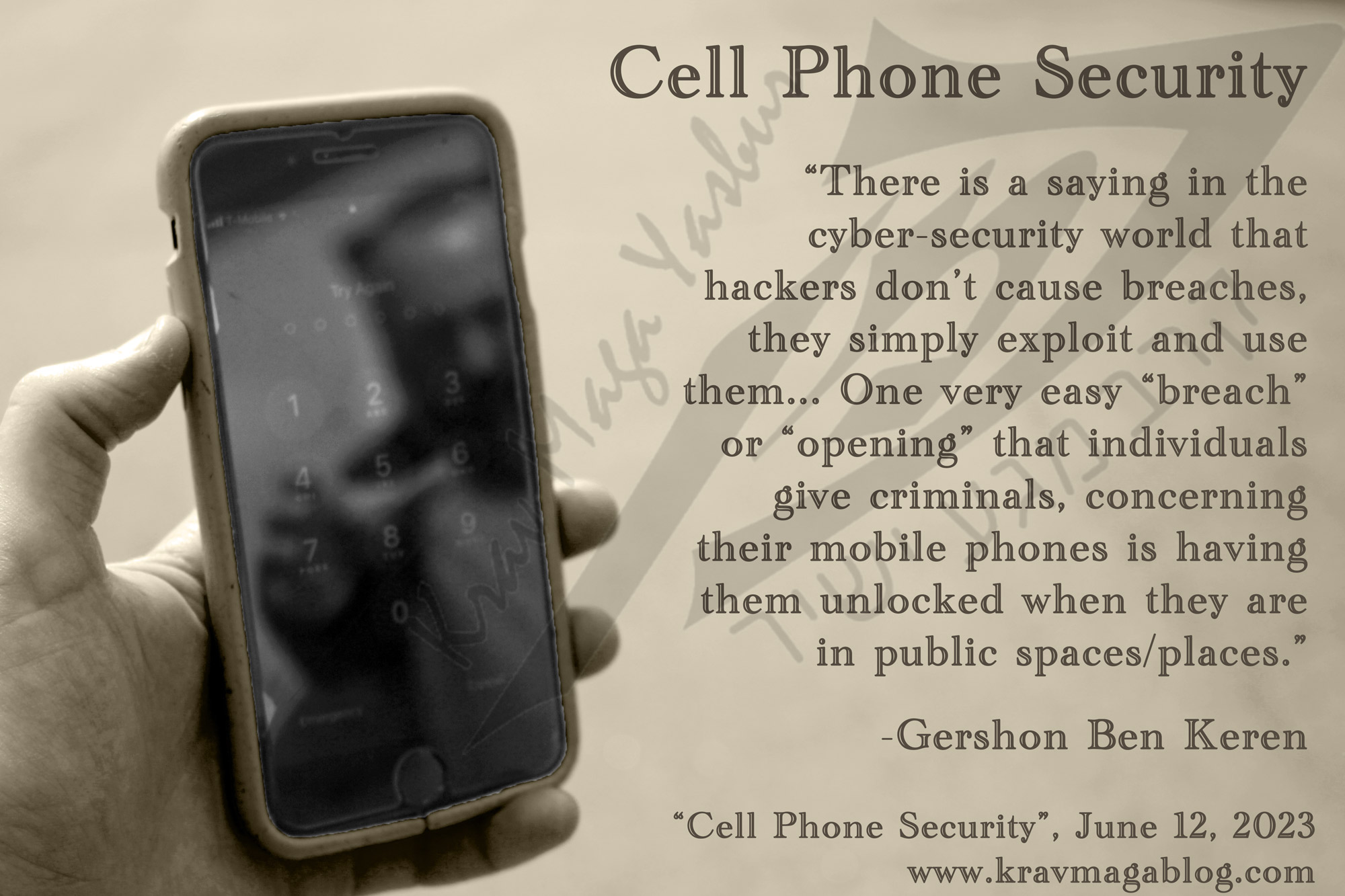Cell Phone Security, is an article written by Gershon Ben Keren, a 5th Degree Black Belt in Krav Maga, who teaches Krav Maga in Boston, MA. He has also authored three Amazon best-Selling Books on Krav Maga.
I have written about mobile phones, from a personal safety perspective, before e.g., about how they can make us feel safe, even though they put us in more danger (Click Here), how they allow us to hand over control of a situation to someone who is not there (Click Here), and how we can hand over control of our safety to apps and devices, rather than taking responsibility for ourselves (Click Here) etc., however I haven’t written much about security concerning the device itself. In this article I want to look at how to mitigate the risk of devices being stolen, and what to do/not do, if they are.
There is a saying in the cyber-security world that hackers don’t cause breaches, they simply exploit and use them. If someone didn’t update the patches sent to them, and some of these included the latest security updates, the hacker didn’t cause this breach or gap, that allowed them to get in, the individual who didn’t apply the update “allowed” the breach to occur. Software companies such as Microsoft often get a bad rap for having leaky and unsecure software, however on many occasions when hackers gain access to our networks and machines it is down to the individual having not run the patches sent to them, and/or working on an outdated and no longer valid supported version of the software. One very easy “breach” or “opening” that individuals give criminals, concerning their mobile phones is having them unlocked when they are in public spaces/places. If an unlocked mobile phone is snatched/stolen when a person is using it, then whoever takes it has access to whatever apps are open on that device. Having it unlocked is akin to having not applied an up-to-date security patch on software; it provides an easy gap for an offender to get through and gain access to a person’s data/information. In many European cities (though this type of offending isn’t restricted to these locales) there are criminals who ride around on mopeds – sometimes with an accomplice riding pillion – snatching phones out of people’s hands; possibly whilst they are waiting at pedestrian crossings or standing at the side of the road etc. Few people, when using their phones, are aware of their surroundings (or at the very least are easily distracted), and so they fail to see a bike, synchronizing its movement with them and getting ready to snatch their phone. A good general habit to get into when using a device, is to make sure it is locked the moment that it’s not being used.
A bad habit to get into is putting your mobile phone down on a table in a restaurant or café. People often do this because they want to make sure they don’t miss a call or a text etc., and to keep taking a phone out of a pocket when it buzzes would become tiresome. However, putting things such as phones, wallets, and keys on a table, makes them accessible for thieves looking for an easy snatch/grab. Sometimes such thefts may be extremely overt with the offender making no attempt to hide and disguise what they are doing e.g., if a person has their phone and/or other assets on a table at a street café, an individual can easily grab these items and run off, before the target realizes what has happened. In other instances, the theft may be more covert e.g., in a crowded bar or restaurant a thief may be able to take whatever is on the table unnoticed, whilst the target is engaged in conversation with others who are with them. When alcohol is involved and people become relaxed, their awareness often drops, making them more susceptible to such crimes. Just as an open street can give an offender an opportunity to create distance quickly, so can a crowd, and if the individual was able to make the theft without the target getting a good look at them, then it will be difficult to identify them as they make their escape.
If your phone is stolen in one of these scenarios, from a personal safety perspective it is unwise to go after, and give chase to the individual who has taken it, unless there are security personnel present e.g., there is a doorman who you can get to intervene on your behalf etc. In many cases these types of simple thefts involve more than one individual, and giving chase to someone may mean that you end up having to confront a group, if you even catch up with them (the fact that you ae having to react and decide what to do probably means they are too far in front of you, however you might want to imagine you’ll react). This could see you then losing more than just your phone, as you may now find yourself dealing with multiple assailants who may be armed. If someone was able to physically get hold of your phone then they exploited a breach that was created for them, and although not to blame for having your phone stolen (that is entirely on the offender), you should recognize how you helped facilitate the crime, and move into damage limitation mode. This means accepting that the device has gone, and taking the decision to wipe all the personal data that is on it, before the offender(s) unlock it. Most offenders will not have this knowledge and ability and will need to take it to someone who does, such as a third party who sells used mobile phones etc. This means that you should have enough time to clean the device. Android phones have a feature called “Find my Device” (Click Here to access), that allows you to remotely wipe your data, and for the iPhone it can be managed remotely using “Find My” (Click Here to access). There are also a variety of third-party apps you can use/install etc. to accomplish the same thing. If your phone is switched off when you use these tools as soon as it comes back on, your data will be wiped, and the factory settings restored.
Whenever thinking about mobile phone security and safety it is always worth remembering that it is the data and information on the phone that is valuable, not the device itself (that is something that can easily be replaced). If you use your phone to store a lot of data and have turned it into a repository of information and apps that would be hard to replace, you should think about regularly cloning it, so that you are able to restore your phone onto another device (a quick google search for “cloning a mobile phone” will bring these up. There are many cloning tools that exist and are easy to use. Ultimately, never leaving your phone accessible (and unlocked) to potential offenders is one of the best security measures you can take.
0 COMMENTS















